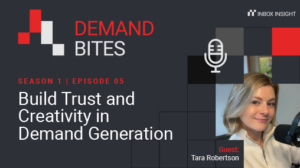Designing and executing demand generation activities that reach and drive the right traffic can improve sales and increase revenue through:
- Driving better performance from your digital media programs
- Improving conversion rates
- Delivering better quality leads
- Achieving a higher ROI
This article sets out the key steps to delivering the best plan of attack. Read on to discover how to fuel your demand generation engine…
Reading time: 6 minutes
We’ve reached an exciting time in B2B marketing. Programmatic advertising and biddable/RTB Media is booming and it’s brought with it a whole new plethora of targeting possibilities that make reaching your target audience a tangible reality, without requiring a massive budget.
Traditionally hard-to-reach accounts are now accessible, target account lists (TAL) can be expanded with accurate lookalikes and multiple stakeholders within a DMU can be strategically engaged, all thanks to the new possibilities opened up by programmatic AdTech.
The data is here, along with the means for precision-based targeting. How you make the most of it is entirely down to your research and planning. Before you begin any of this, you need to start by knowing your audience.
How to find and identify the right audience
Identifying your target customer and their demographics, interests and behaviors is a crucial step in any type of marketing strategy. It allows you to tailor your message and content to the right people and create more meaningful connections. Additionally, it helps you focus your efforts on the right channels and platforms, ensuring that you don’t waste time and resources reaching the wrong people.
Here are 4 ways to identify your audience:
1. Create buyer personas for your target audience
Creating buyer personas is a great way for B2B marketers to find and identify their target audience. By creating buyer personas, you can gain a comprehensive understanding of your ideal customers and create a customer base that is actually engaged and interested in your products and services.
Buyer personas help to identify customer behaviors, motivations and interests, so that marketing teams can create relevant content that resonates with their target audience. The more detailed personas are, the easier it is to create content that appeals to them and to shape the marketing campaigns to reach the right people. Personas can also help marketers identify the best channels to reach their target audience, thereby increasing the effectiveness of the marketing campaigns.
2. Make use of your social media presence
Another great way to identify your target audience is by utilizing your presence across various social platforms, posts and channels. By analyzing the demographics, interests and preferences of the users engaging with your content, you can gain insights into who is likely to be their target audience. For example, you can use analytics from their social media posts to track the age group, gender and geographic location of their followers.
Analyzing the topics of your top-performing social media posts can also help you gain insight into your target audience’s interests, such as which topics are resonating most with users and what types of content they prefer.
3. Spy on your competitors
Businesses can use a range of tactics to spy on competitors and identify their ideal target audience. Social media platforms have become increasingly important in this regard, as they provide a direct channel for businesses to observe the types of people engaging with their competitors’ products and services. The types of content that are shared, liked and commented on can provide valuable insight into the interests, values and needs of their target audience.
For instance, businesses can monitor the types of posts that their competitors are sharing and the topics that are driving the most engagement. This can help to identify what their competitors’ target audience is interested in and how they can better engage this audience. By understanding the types of content that resonate most with their target audience, businesses can create content that is more likely to be shared and generate more engagement.
4. Use social listening
Social listening tools are an invaluable resource for businesses to identify their ideal target audience. By analyzing the comments, conversations and feedback of their existing and potential customers, marketers can gain insights that will help them to better identify their target market. These insights can also be used to inform marketing strategies, ensuring that they’re engaging their target market in the most effective way.
What’s more, social listening tools can help you identify influencers in their target market, which can be instrumental in promoting their products and services to their ideal audience.
How do I plan for the ‘right’ leads?
Now that you’ve got an idea of your audience, it’s time to start using media to reach them. However, no matter how much you embrace RTB media, you will not achieve your ROI if you’re not clear on the prospects you’re going after.
In order to identify the ‘right’ types of leads, there are a fair few details you should know or at least be able to take educated guesses about your target audience, including:
-
- Who they are (job titles, location, responsibilities…etc.)
- What influences their buying criteria
- What information do they require
- Which key stakeholders make up their DMU
- Which touchpoints are critical for engagement
- Which trends are shaping their behavior
- What channels they frequently use
- Which thought leaders and influencers hold their trust
Having this insight makes planning and executing your demand generation program a whole lot more effective and is required if you wish to compete in today’s data-savvy marketing environment.
Building a tightly defined target account list and overlaying this list with intent data is now a common practice that supports many winning demand generation strategies.
The 5-step plan of attack
Step 1: Current clients
Start with your current clients – who are the most profitable audience segments? What shared characteristics can you identify? What makes them a good fit for your product/services? How can you use these to inform your list criteria?
Step 2: Create your target account list
Compile your TAL using your defined criteria. It’s crucial the rationale dictating this criteria is robust and well thought out – are you basing this list on research or assumptions?
Step 3: Include lookalikes
Expand your lists with lookalikes and other account that share the same salient characteristics such as firmographic data. This will enable you to scale up your available reach.
Step 4: Include intent
Combine first-party data with third-party data sources to layer on audience understanding such as action-based intent data.
Step 5: Leverage market research
Use marketing research techniques such as telephone surveys to discover qualitative and quantitative insight.
How do I reach and engage my target audience?
In order to make someone take action, you have to identify the right trigger to prompt your desired behavior.
With the average attention span falling from 12 seconds in 2000 to 8.25 seconds and the boom in digital advertising, the fight for attention is on. This means your trigger needs to be on point, as a poorly executed message will no longer cut it.
Here are 3 methods for increasing the likelihood of triggering the right traffic and at the best volumes:
1. Crafting the most compelling message
In order to uncover the key hook that will resonate with your audience and incite them to take action, you need to compile the knowledge accumulated from your target audience planning into a comprehensive content strategy.
Buyer personas are a trusted technique for transforming audience insight into actionable pain points that aid content planning and content creation.
Recommended reading: B2B DMU Buyer Persona Cheat Sheet
2. Leveraging innovative creative
Innovative creative teamed with expertly crafted copy is now a must for forward-thinking B2B marketers. Highly visual platforms are increasingly the norm even in the B2B sphere, changing the way we experience and consume information. Therefore, if you want to get a step ahead, you must recognize the importance of well-executed creative. Here are two resources to help tackle any programmatic elements of your content strategy:
3. Taking a multi-channel approach to increase touchpoints and reach
The best content in the world is useless if the right people don’t see it. It’s not the case that good content will always be found: the world of content is extremely competitive, and audiences have limited time.
You need to work hard, and often creatively, to make sure it’s seen – and acted upon.
Biddable/RTB Media and programmatic advertising enable you to precisely target groups, TALs or even individuals with precisely targeted content. You can cost-effectively resurface your message and content to prospects even when you don’t have their email address. Used in combination with social media platforms or other channels, this can greatly accelerate the prospecting stage and provide a powerful boost, progressing leads through your demand generation engine at greater speed and effectiveness.






